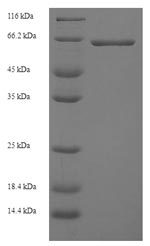The expression region of this recombinant Human PKLR covers amino acids 1-574. This PKLR protein is theoretically predicted to have a molecular weight of 65.8 kDa. This PKLR recombinant protein is manufactured in e.coli. The PKLR coding gene included the N-terminal 6xHis tag, which simplifies the detection and purification processes of the recombinant PKLR protein in following stages of expression and purification.
Human pyruvate kinase isozyme R/L (PKLR) is primarily found in the liver and red blood cells. It is involved in the final step of glycolysis, where it catalyzes the conversion of phosphoenolpyruvate (PEP) to adenosine diphosphate (ADP), generating pyruvate and ATP. In red blood cells, PKLR is crucial for energy production and maintaining cell integrity. Research on PKLR includes investigations into its role in glycolytic regulation, metabolic disorders, and its significance in various tissues. Mutations in the PKLR gene can lead to pyruvate kinase deficiency, a condition associated with hemolytic anemia.






